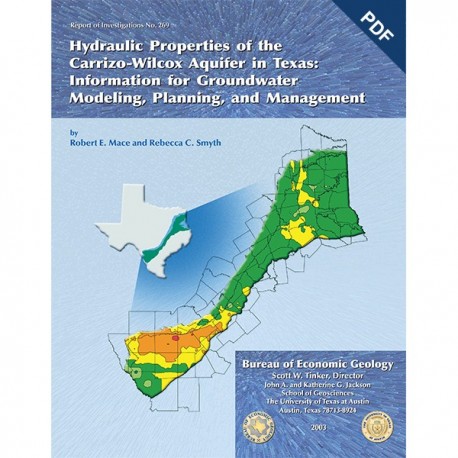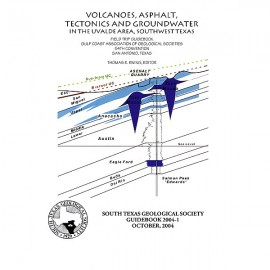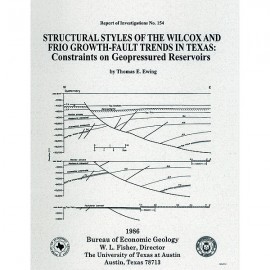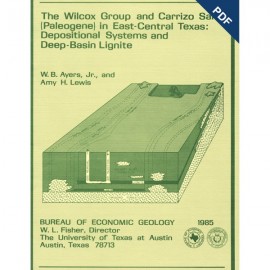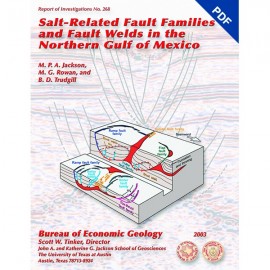Reports of Investigations
-
Books & Reports
- Reports of Investigations
- Guidebooks
- Udden Series
- Geological Circulars
- Down To Earth
- Atlases of Major Oil and Gas Reservoirs
- Texas Memorial Museum Publications
- Environmental Geologic Atlas of the Texas Coastal Zone
- Mineral Resource Circulars
- Other Reports
- Seminars and Workshops
- Handbooks
- Submerged Lands of Texas
- Symposia
- Annual Reports
- Open File Reports
-
Maps & Cross Sections
- Thematic Maps
- Miscellaneous Maps, Charts & Sections
- Geologic Atlas of Texas
- STATEMAP Project Maps
- Geologic Quadrangle Maps
- Cross Sections
- Highway Geology Map
- Energy and Mineral Resource Maps
- Shoreline Change and Other Posters
- Wilcox Group, East Texas, Geological / Hydrological Folios
- Bouguer Gravity Atlas of Texas
- River Basin Regional Studies
- Featured Maps
- Posters
- Teachers & the Public
-
Geological Society Publications
- Gulf Coast Association of Geological Societies
- Alabama Geological Society
- Austin Geological Society
- Corpus Christi Geological Society
- Houston Geological Society
- Lafayette Geological Society
- Mississippi Geological Society
- New Orleans Geological Society
- South Texas Geological Society
- GCS SEPM Publications
- Historic BEG & UT Series
Hydraulic Properties of the Carrizo-Wilcox Aquifer in Texas...Digital Download
RI0269D
For a print version: RI0269.
RI0269D. Hydraulic Properties of the Carrizo-Wilcox Aquifer in Texas: Information for Groundwater Modeling, Planning, and Management, by R. E. Mace and R. C. Smyth. 40 p., 23 figs., 12 tables, 2003. ISSN:2475-367X. doi.org/10.23867/RI0269D. Downloadable PDF.
To purchase this publication in book format, please order RI0269.
ABSTRACT
Use of groundwater-flow models for prediction of future availability of water resources is standard practice. Having accurate hydraulic parameters for input into groundwater-flow models is critical to the generation of realistic local and regional water-resource management plans. Transmissivity, hydraulic conductivity, and storativity are some of the important parameters needed for developing numerical groundwater-flow models. These hydraulic parameters provide information on how easily water flows through an aquifer, how much water is stored in an aquifer, and how rapidly an aquifer responds to pumping and recharge. The Carrizo-Wilcox aquifer is a major Texas aquifer that is utilized widely by domestic and industrial users in 60 Texas counties between the Rio Grande and the Sabine River. The entire aquifer occurs along a 50- to 100-mi-wide band, which lies inland approximately 100 mi and parallel to the Gulf of Mexico in Texas, Arkansas, and Louisiana. To date, references to Carrizo-Wilcox aquifer hydraulic properties are scattered among various State and public documents, including those of the Texas Water Development Board (TWDB), the Texas Commission on Environmental Quality (TCEQ), and the Railroad Commission of Texas (RRC), among others.
Herein we have compiled and statistically analyzed transmissivity, hydraulic-conductivity, and storativity values from numerous sources of data for the entire Carrizo-Wilcox aquifer in Texas. Results include a database of 7,402 estimates of hydraulic properties in 4,456 wells. The database shows that transmissivity of the Carrizo-Wilcox aquifer ranges from 0.1 to 10,000 ft2/d and has a geometric mean value of 300 ft2/d and that hydraulic conductivity ranges from 0.01 to 4,000 ft/d and has a geometric mean value of 6 ft/d. Transmissivity and hydraulic conductivity results for all hydraulic tests in the Carrizo-Wilcox aquifer are lognormally distributed. Transmissivity and hydraulic conductivity vary spatially, both vertically and areally, in the Carrizo-Wilcox aquifer. Geologic units composing the aquifer are the Simsboro and Calvert Bluff Formations of the Wilcox Group and the unconformably overlying Carrizo Sand.
The Simsboro Formation and Carrizo Sand portions of the Carrizo-Wilcox aquifer have transmissivity and hydraulic-conductivity values that are 2.5 to 11 times higher and 2 to 6 times higher, respectively, than those of lower permeability units of the aquifer. Semivariograms show that transmissivity and hydraulic-conductivity values in the Carrizo Sand and undivided Wilcox Group are spatially correlated over about 17 and 25 mi, respectively. Large nuggets in the semivariograms suggest local-scale heterogeneity and measurement errors. Kriged maps of transmissivity and hydraulic conductivity show the greatest values for the Carrizo Sand in the Winter Garden area of South Texas. Highest values of transmissivity and hydraulic conductivity for the undivided Wilcox Group occur in the south-central and northeast parts of the aquifer. Storativity and specific storage values approximate lognormal distributions. Storativity ranges from about 10-6 to 10-1, with a geometric mean of 3.0 x 10-4. Specific storage ranges from about 10-7 to 10-3 ft-1, with a geometric mean of 4.5 x 10-6 ft-1. Higher values of storativity and specific storage tend to occur at shallow depths, where the aquifer is unconfined.
Keywords: Carrizo-Wilcox aquifer, hydraulic conductivity, specific capacity, storativity, Texas aquifer, transmissivity
CONTENTS
ABSTRACT
INTRODUCTION
STUDY AREA
Geological Framework
METHODS
Literature Review
Data Compilation
Evaluation of Hydraulic Properties in Database
Estimating Transmissivity from Specific-Capacity Data
Statistical Description
RESULTS AND DISCUSSION
General Characteristics of Database
Transmissivity and Hydraulic-Conductivity Values
Variations in Values from Different Sources
Variations in Values Due to Different Testing Methods
Spatial Distribution of Transmissivity and Hydraulic Conductivity
Vertical Variability of Transmissivity and Hydraulic Conductivity
Lateral Variability of Transmissivity and Hydraulic Conductivity
Relationship between Hydraulic Conductivity and Sand Thickness
Storativity
CONCLUSIONS
ACKNOWLEDGMENTS
ACRONYMS
REFERENCES
APPENDIX A. Carrizo-Wilcox data files (on CD-ROM in back of printed book)
Figures
1. Location of outcrop and subcrop of the Carrizo-Wilcox aquifer in Texas
2. Lower Tertiary stratigraphy in South Texas, Central Texas, and Sabine Uplift, Texas
3. Structural elements that affected Tertiary sedimentation along the Texas Gulf Coast
4. Aquifer thickness and percent sand for the lower Claiborne-upper Wilcox aquifer and middle Wilcox aquifer
5. Texas well-numbering system
6. Relationship between specific capacity and transmissivity in the Carrizo-Wilcox aquifer
7. Comparison of ratios of estimated to measured transmissivity for transmissivity estimated by analytical and empirical approaches
8. Example semivariogram showing range, sill, and nugget
9. Distribution of aquifer-test wells in the Carrizo-Wilcox aquifer
10. Number of aquifer tests in Texas counties
11. General characteristics of wells and aquifer tests in the database
12. Histograms of all estimates of transmissivity and hydraulic conductivity from the Carrizo-Wilcox aquifer
13. Cumulative distribution functions of transmissivity and hydraulic conductivity for different data sources
14. Cumulative distribution functions of transmissivity and hydraulic conductivity for different test types
15. Cumulative distribution functions of transmissivity and hydraulic conductivity for different geologic units using data collected from TWDB files
16. Cumulative distribution functions of transmissivity and hydraulic conductivity for north, central, and south areas of the aquifer
17. Experimental and theoretical semivariograms of log transmissivity and log hydraulic conductivity in the Carrizo Sand and Wilcox Group
18. Spatial distribution of transmissivity in the Carrizo Sand using kriging values from the TWDB database
19. Spatial distribution of hydraulic conductivity in the Carrizo Sand using kriging values from the TWDB database
20. Spatial distribution of transmissivity in the Wilcox Group using kriging values from the TWDB database
21. Spatial distribution of hydraulic conductivity in the Wilcox Group using kriging values from the TWDB database
22. Histograms of storativity and specific storage for the Carrizo-Wilcox aquifer
23. Variation of storativity and specific storage with depth
Tables
1. Thickness of Carrizo and Wilcox stratigraphic units in four structural settings
2. Cities and water utilities responding to the survey
3. Characteristics of wells and tests in the database
4. Transmissivity values estimated from aquifer tests
5. Hydraulic-conductivity values estimated from aquifer tests
6. Transmissivity and hydraulic-conductivity values compiled from lignite mine permit reports on file at the RRC
7. Hydraulic-conductivity values reported by Prudic
8. Transmissivity values from the TWDB database for different counties in the study area
9. Hydraulic-conductivity values from the TWDB database for different counties in the study area
10. General areal distribution of transmissivity and hydraulic-conductivity values
11. Fitting parameters for the theoretical semivariograms
12. Storativity and specific storage values for the Carrizo-Wilcox aquifer
Citation
Mace, R. E., and Smyth, R. C., 2004, Hydraulic Properties of the Carrizo-Wilcox Aquifer in Texas: Information for Groundwater Modeling, Planning, and Management: The University of Texas at Austin, Bureau of Economic Geology, Report of Investigations No. 269, 40 p. doi.org/10.23867/RI0269D.
